A1.2 Nucleic Acids - IB1 Biology - 2025
1/60
Earn XP
Name | Mastery | Learn | Test | Matching | Spaced |
|---|
No study sessions yet.
61 Terms
4 major types of biological molecules
Carbohydrates
Lipids
Proteins
Nucleic Acids
Function of Nucleic Acids
2 Primary Functions
Passes information between generations
Code for protein production
Types of Nucleic Acids
DNA: Deoxyribonucleic Acid
RNA: Ribonucleic Acid
DNA
Passes heredity information between generations of cells
DNA replication
Information stored in DNA, which passes cell to cell through generations
Codes for making RNA during transcription
Instructions to make proteins
DNA → Messenger (RNA) → Makes proteins
RNA
Codes for making proteins during translation
mRNA, rRNA, and tRNA are the three main types of RNA involved in protein synthesis
Similarities of DNA and RNA
polymers of nucleotides
sugar-phosphate backbone
Differences of DNA and RNA
DNA
Double Helix
Information passes from generation to generation
Has code to make RNA
RNA
Single Helix
Makes Proteins
3 Types of RNA
mRNA: Messenger
rRNA: Ribosomal
tRNA: Transfer
DNA is UNIVERSAL to life
Outline the meaning and implication of DNA being the genetic material of all living organisms.
all living things use DNA as the genetic material
Implication:
The use of the genetic code across all forms of life is evidence of universal common ancestry of life. The sequences of DNA in cells can be analyzed and compared to determine evolutionary relationships between organisms. The more similar the sequence, the more closely related the organisms.
Viruses don’t have DNA
State why RNA viruses do not falsify the claim that all living things use DNA as the genetic material.
because they are not living things, but can contain RNA and DNA
Parts of a Nucleotide
A purine or pyrimidine nitrogenous base
Adentine (A)
Thymine (T) (Only for DNA)
Cytosine (C)
Guanine (G)
Uracil (U) (Only for RNA
a five-carbon “pentose” sugar (ribose or deoxyribose)
A negatively charged phosphate group (PO4-).
How are nucleic acids are polymers of nucleotides?
They are combined in condensation reactions
Structure of a Nucleotide
The phosphate group and nitrogenous base must connect at the correct corners of the pentagon
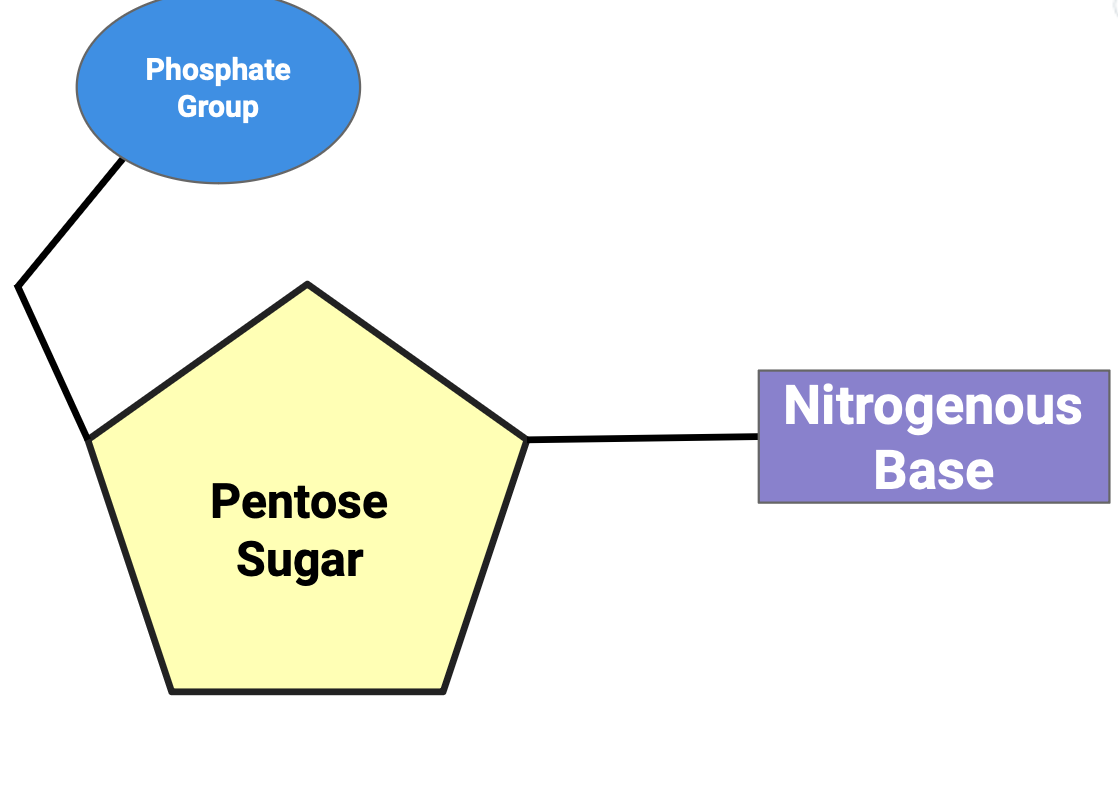
Identify and label the carbons of a pentose sugar.
The carbons of the sugar component of the nucleotide are numbers clockwise, starting from the oxygen in the ring at the top and the phosphate group to the left.
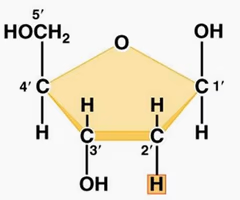
Define “backbone” as related to nucleic acid structure.
The “backbone” is the alternating phosphate-sugar- phosphate-sugar-phosphate… found in a polymer of nucleic acids. The relative strength of the backbone maintains the nucleotides in their specific sequence.
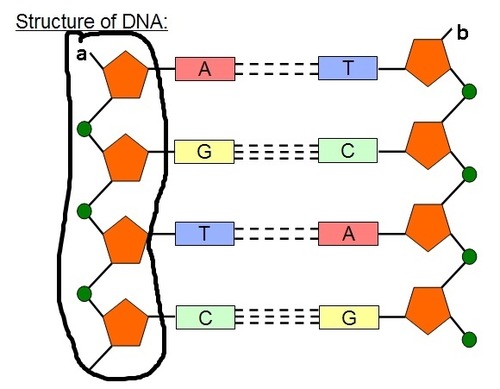
Explain how nucleotides can connect to form a nucleic acid polymer.
Nucleotides connect by creating covalent bonds between the sugar of one nucleotide and the phosphate group of another nucleotide in a condensation reaction.
The 5’ phosphate group on one nucleotide forms a new covalent bond with the 3' carbon on the pentose of the next nucleotide. Water is created as a biproduct.
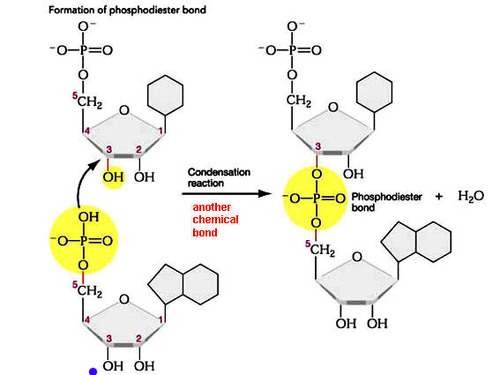
DNA Backbone
two sugar-phosphate backbones that run antiparallel to each other and twist together in a helical shape
RNA Backbone
one sugar-phosphate backbone
depending on the type of RNA, the molecule can twist and bind to itself.
“Backbone” as Structural Support
The sharing of electrons in the covalent bond between sugar and phosphate provides strength to the structure. It helps maintain their sequence which is necessary for the storing, replication and expression of genetic information
State the names of the nitrogenous bases found in DNA and RNA.
Cytosine (DNA and RNA)
Thymine (DNA only)
Guanine (DNA and RNA)
Adenine (DNA and RNA)
Uracil (RNA only)
Outline how the sequence of bases in a nucleic acid serves as a ‘code.’
A code is a system in which one symbol signifies the meaning of another symbol. In the genetic code, a group of three nucleic acid bases signifies for an amino acid.A gene is a specific sequence of DNA nucleotides that codes for the making of a specific protein.
Define gene.
A gene is a specific sequence of nitrogenous bases in DNA nucleotides that codes for the making of a protein.
Purines
Meaning double-ring structure
Examples: Guanine and Adenine
Pyrimidines
Meaning single-ring structure
Examples: Cytosine, Thymine, and Uracil
Describe the condensation reaction that forms a polymer of RNA from RNA nucleotides.
RNA nucleotides connect by creating covalent bonds between the ribose sugar of one nucleotide and the phosphate group of another nucleotide in a condensation reaction.
The 5’ phosphate group on one RNA nucleotide forms a new covalent bond with the 3' carbon on the ribose of the next nucleotide. Water is created as a biproduct.
Draw a short section of an RNA polymer (using circle, pentagon and rectangle)
Include at least three RNA nucleotides, drawn as circle (phosphate), hexagon (ribose) and rectangle (base).
Be sure the phosphate of one nucleotide is connected to the 2'C of the adjacent nucleotide.
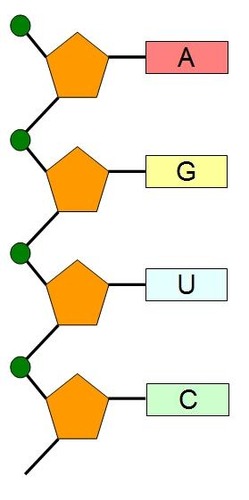
Outline the complementary base pairing rule, including the type and number of bonds between bases.
In DNA, the nitrogenous bases of two antiparallel strands form hydrogen bonds with each other. The complementary base pairing rule is that adenine only binds with thymine (with 2 H-bonds) and that guanine only binds with cytosine (with 3 H-bonds).
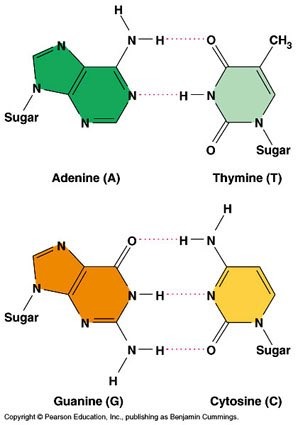
Describe the structure of a DNA double helix.
Two polymers of DNA nucleotides, each with a sugar-phosphate backbone, run in antiparallel directions. Complementary DNA nitrogenous bases (A-T, C-G) form hydrogen bonds between them, binding the two polymer stands ("double") so that they wind around each other ("helix")
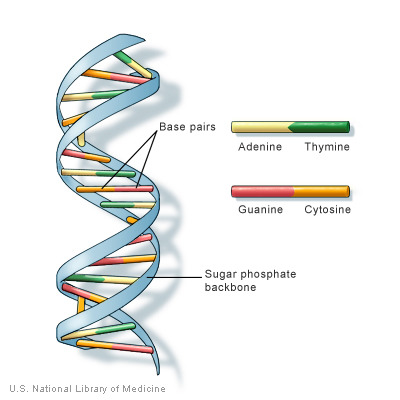
Define antiparallel in relation to DNA structure.
Adjacent molecules are oriented parallel to each other but oriented in opposite directions.
In DNA, one strand runs 5' to 3' and the complementary strand runs 3' to 5'
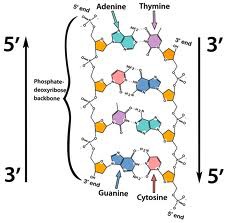
What are nitrogenous bases joined together by?
The double helix of DNA is held together by hydrogen bonds between the nitrogenous bases
Hydrogen bonds are weak chemical attractions between two polar molecules
Compare and contrast the location of DNA and RNA in prokaryotic and eukaryotic cells.
Eukaryotic Cells
Both DNA and RNA are found in the nucleus.
DNA also in mitochondria and chloroplasts.
RNA also in cytoplasm and as part of ribosomes (free or bound to rough ER)
Prokaryotic Cells
Both DNA and RNA are in the cytoplasm.
DNA is clumped in a region called the nucleoid.
Compare and contrast the structure of DNA and RNA.
Both are nucleic acids formed through condensation of nucleotides. Both DNA and RNA have a sugar-phosphate backbone.
RNA
ribose
single stranded
nitrogenous bases A, G, C, U
Complementary paring A-U, C-G
DNA
deoxyribose
double stranded
nitrogenous bases A, G, C, T
Complementary pairing A-T, C-G
Explain the role of complementary base pairing in maintaining the DNA sequence during DNA replication.
During DNA replication, the two strands of a "parent" DNA molecule are broken apart. Each of these strands serves as a template for the creation of a new "daughter" strand. Because of the base pairing rule, the parent template strand will always code for the complementary sequence of nucleotides in the daughter strand (A to T, C to G). The complementary base paring will maintain the sequence of the DNA from generation to generation.
Outline the role of complementary base pairing in transmitting the genetic code in transcription.
During transcription, one of the the two strands of a DNA molecule is used as a template for the creation of an RNA strand. Because of the base pairing rule, the DNA template strand will always code for the complementary sequence of RNA nucleotides in the (A to U, C to G). The complementary base paring will maintain the sequence of the gene as mRNA is translated into protein.
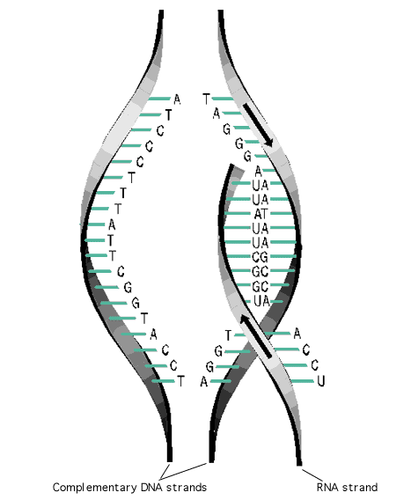
Outline the role of complementary base pairing in transmitting the genetic code in translation.
During translation, an RNA strand is used as a template for the creation of a polypeptide. Because of the base pairing rule, the mRNA codon will only bind with the complementary tRNA anticodon (A to U, C to G). The complementary base paring ensures the correct amino acid are brought in the correct sequence to the ribosome.
Outline why there is a limitless diversity of DNA base sequences.
There are four nitrogenous bases in DNA (A, T, C and G). These 4 bases are components of nucleotides that can form a DNA molecule in any order and of any length.
Define universal in relation to the genetic code.
Universal means that the characteristic is shared by all life. A universal generic code means that all life uses essentially the same code when translating information stored in genes into a polypeptide.
Outline why conservation of the genetic code across all forms of life is evidence of common ancestry.
Using inductive reasoning, it can be concluded that the use of the same genetic code across all forms of life indicates that all organisms inherited the use of the code from a common ancestor. The alternative, that all forms of life independently developed use of the same genetic code, is an illogical hypothesis.
The explanation for this universality is that the genetic code was the one carried by the last universal common ancestor of life and it has been passed over time to all of its descendants.
(HL) Identify and label the 5’ and 3’ ends on a DNA or RNA diagram.
Each end of DNA nucleotide has a number. One end is referred to as 5' (five prime) and the other end is referred to as 3' (three prime). The 5' and 3' designations refer to the number of the carbon atom in a deoxyribose sugar molecule. The 5' end is identified by the presence of the phosphate group and the 3' end is identified as ending in the pentose sugar (ribose or deoxyribose).
In DNA, one strand will run from 5' to 3' and the complementary strand will run anti-parallel, from 3' to 5'.
(HL) Leading vs Lagging
Leading: At the opening of replication fork
Lagging: Opposite the opening of replication fork
(HL) DNA Replication
Production of exact copies of DNA from parent strand template
DNA polymerase only add 3’
5’ is added to 3’ of the growing DNA strand
(HL) Transcription
5’ → 3’
RNA polymerase can only add nucleotides to 3’ end of a growing polymer of RNA nucleotide
(HL) Translation
5’ → 3’
1) Ribosome attached to 5’ end of mRNA
2) RIbosome moves along mRNA → 3’
(HL) Directionality
It affects the way enzymes can bind to and function when bound to nucleic acids
DNA polymerase during transcription
Ribosome during translation
(HL) Given a diagram of DNA, identify the four bases of DNA based on purine or pyrimidine and the number of hydrogen bonds.
Purines have two rings. If it can form 2 H-bonds it is adenine and if it can form 3 H-bonds it is guanine.
Pyrimidines have one ring. If it can form 2 H-bonds it is thymine and if it can form 3 H-bonds it is cytosine.

(HL) State that in DNA, a purine forms hydrogen bonds with a pyrimidine.
In DNA, a purine complementary base pairs to a pyrimidine using hydrogen bonds
In DNA and RNA, guanine bonds with cytosine with three hydrogen bonds.
In DNA, adenine bonds with thymine with two hydrogen bonds.
In RNA, adenine bonds with uracil with two hydrogen bonds
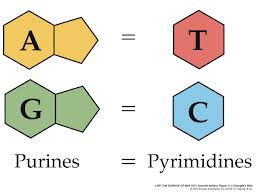
(HL) 2 Consequences Purine-to-Pyrimidine Bonding
When a pyrimidine is paired with a purine, the width dimension of both pairs is identical. = consistent diameter throughout the entire molecule.
Hydrogen bonding creates great stability to DNA’s double helix
Consistent diameter throughout the entire molecule.
(HL) Draw and label the structure of a nucleosome, including the H1 protein, the octamer core proteins, linker DNA and two wraps of DNA.
The nucleosome is the basic unit of DNA packaging in eukaryotes. Each nucleosome is composed of two turns of DNA wrapped around a group of eight histone proteins (called an octamer core). Each nucleosome connects to the adjacent nucleosomes through another type of histone protein (called the H1) and a region of "linker" DNA.
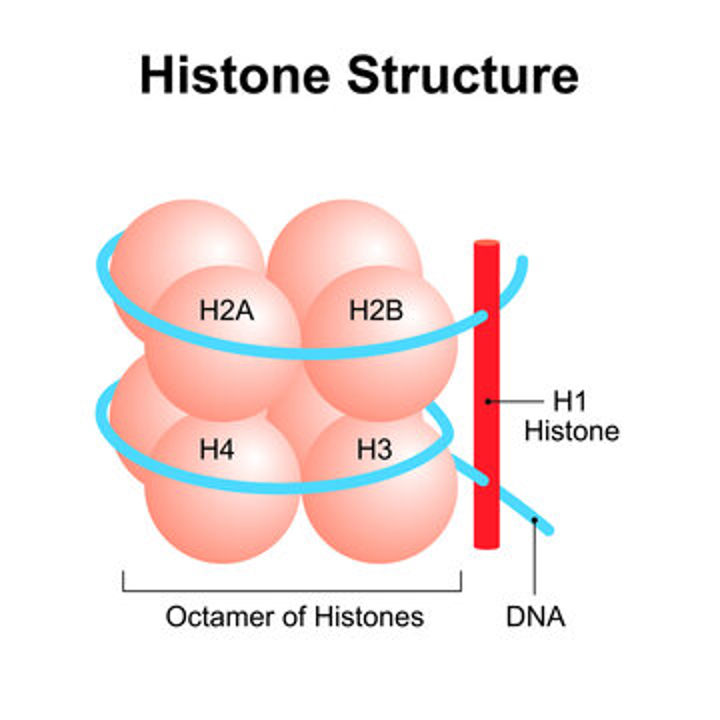
(HL) Describe the structure of eukaryotic DNA and associated histone proteins during interphase (chromatin).
To compact DNA while regulating gene accessibility for transcription, eukaryotic organisms organize their genomes:
1. DNA double helix.
2. DNA wraps around histone proteins, forming nucleosomes and the "beads on a string" structure.
3. Multiple nucleosomes wrap into a fibre (chromatin).
4. Supercoiling of the chromatin produces the chromosome (during mitosis and meiosis). Supercoiling refers to the repeated twisting and winding of the DNA strand. Supercoiling functions to reduce the space required for DNA packaging, allowing for more compact storage of DNA.
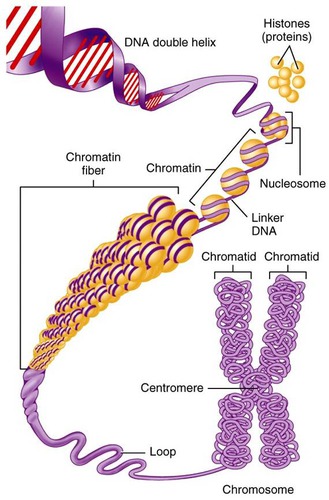
(HL) DNA Packaging
Layers of coils that compact the molecule
Diameter of DNA is 2nm
Protein called histones help compact the DNA
8 histones, DNA wraps twice around them
(HL) DNA Unpacking
Replication fork
Nucleosomes are disassembled ahead in front fork, and reassembled before
(HL) State the experimental question being tested in the Hershey and Chase experiment.
Both protein and nucleic acids are part of the eukaryotic cell nucleus, and prior to 1952 it was unknown which molecule type was responsible for passing genetic information between generations. Hershey and Chase designed an experiment to test whether proteins or DNA is the hereditary material.
(HL) Outline the procedure of the Hershey and Chase experiment.
Hershey and Chase (H&C) conducted experiments on bacteriophages, which are viruses that infect bacteria. They used radioactive phosphorus and sulfur isotopes to label phages. DNA in phages contains phosphorus but not sulfur, while protein contains sulfur but not phosphorus. This allowed them to distinguish between the DNA and protein components of the phages.
They observed that when phages infected bacteria and replicated, only the DNA entered the host bacteria. This demonstrated that DNA was the genetic material responsible for replication in phages, as the protein coats remained outside, attached to the bacterial membranes.
(HL) Explain how the results of the Hershey and Chase experiment supported the notion of nucleic acids as the genetic material.
The molecule of heredity must be passed from generation to generation. When Hershey and Chase demonstrated that radioactively tagged DNA is present across generations of bacteriophages and that radioactively tagged protein is not, they demonstrated that nucleic acids must be the genetic material.
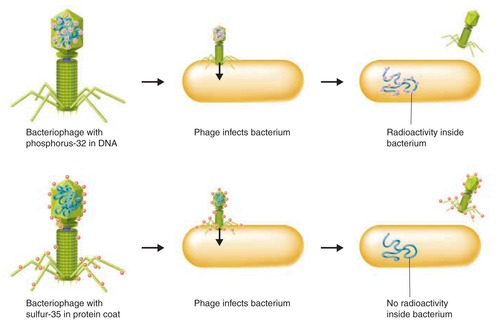
(HL) Outline the use of radioisotopes as research tools.
Hershey and Chase relied on radioactive isotopes of phosphorus and sulfur in their experiment to determine that DNA is the genetic material.
Because they give off energy as they convert to a more stable form, the isotopes allow biologists to track molecules as they move through biological systems.
(HL) Explain the role of falsifiability in determining the structure and function of DNA.
To falsify means that a statement, theory or hypothesis is proven to be wrong.
Because he found that the amount of one base wasn't equal to the amount of the three other bases , Chargaff's data falsified the earlier hypothesis that DNA had a tetranucleotide structure. In this proposed model of DNA, the four bases occur in equal amounts in four strands arranged with the bases facing outward.
(HL) Describe the implications of Chargaff’s data that showed a 1:1 ratio of purine to pyrimidine in a sample of DNA.
Chargaff's research revealed the percentage of each base (A, T, C, G) found in different species DNA. He determined that there are equal numbers of A and T bases and G and C bases in a DNA sample, resulting in a 1:1 ratio of purines to pyrimidines in DNA.
Chargaff did not use inductive reasoning to then infer the pattern that A binds to T and C binds to G. The complementary base pairing rule was inferred by Watson and Crick.
(HL) X-Ray Crystallography : Florence Bell
It suggests that DNA has a repeating pattern and Bell’s work indicated that DNA is a regular, ordered structure that could be studied using X-ray crystallography.
(HL) Frequencies of Nitrogenous Bases : Erwin Chargraff
showed that 4 frequencies were not equal
he proved A can connect to T only in DNA
+ C and G can connect to each other ONLY
(HL) X-Ray Crystallography : Rosalind Franklin
discovered that DNA is
double helix
twisted
anti parallel
(HL) Triple Strand Model of DNA : Linus Pauling
proposed that DNA was
triple helix
phosphate backbone on the inside
nucleotide bases pointing outwards.
it was disproven because negatively charged phosphates would repel each other,
(HL) Double Helix of DNA : James Watson & Francis Crick
built the model to determine the double helix structure of DNA in April 25, 1953